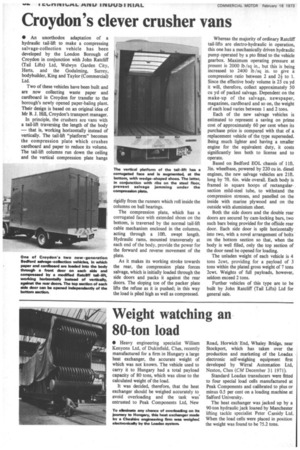Croydon's clever crusher vans
Page 34

If you've noticed an error in this article please click here to report it so we can fix it.
• An unorthodox adaptation of a hydraulic tail-lift to make a compressing salvage-collection vehicle has been developed by the London Borough of Croydon in conjunction with John Ratcliff (Tail Lifts) Ltd, Welwyn Garden City, Herts, and the Godalming, Surrey, bodybuilder, King and Taylor (Commercial) Ltd.
Two of these vehicles have been built and are now collecting waste paper and cardboard in Croydon for transfer to the borough's newly opened paper-baling plant. Their design is based on an original idea of Mr B. J. Hill, Croydon's transport manager.
In principle, the crushers are vans with a tail-lift traversing the length of the body — that is, working horizontally instead of vertically. The tail-lift "platform" becomes the compression plate which crushes cardboard and paper to reduce its volume. The tail-lift columns run down the ceiling and the vertical compression plate hangs rigidly from the runners which roll inside the columns on ball bearings.
The compression plate, which has a corrugated face with extended shoes on the bottom, is traversed by the normal tail-lift cable mechanism enclosed in the columns, acting through a 10ft, swept length. Hydraulic rams, mounted transversely at each end of the body, provide the power for the forward and reverse movement of the plate.
As it makes its working stroke towards the rear, the compression plate forces salvage, which is initially loaded through the side doors and packs it against the rear doors. The sloping toe of the packer plate lifts the refuse as it is pushed; in this way the load is piled high as well as compressed. Whereas the majority of ordinary Ratcliff tail-lifts are electro-hydraulic in operation, this one has a mechanically driven hydraulic pump operated by a pto fitted to the vehicle gearbox. Maximum operating pressure at present is 2000 lb /sq in., but this is being increased to 2400 lb /sq in. to give a compression ratio between 2 and 2+ to 1. Since the effective body volume is 23 cu yd it will, therefore, collect approximately 50 cu yd of packed salvage. Dependent on the make-up of the salvage, newspaper, magazines, cardboard and so on, the weight of each load varies between 1 and 2 tons.
Each of the new salvage vehicles is estimated to represent a saving on prime cost of approximately 60 per cent when its purchase price is compared with that of a replacement vehicle of the type superseded. Being much lighter and having a smaller engine for the equivalent duty, it costs significantly less both to license and to operate.
Based on Bedford EOL chassis of lift. 3in. wheelbase, powered by 220 cu in. diesel engines, the new salvage vehicles are 21ft. long by 7ft. 6in. wide overall. Each body is framed in square hoops of rectangular. section mild-steel tube, to withstand the compression stresses, and panelled on the inside with marine plywood and on the outside with aluminium sheet.
Both the side doors and the double rear doors are secured by cam-locking bars, two such bars being provided for the offside rear door. Each side door is split horizontally into two, with a novel arrangement of bolts on the bottom section so that, when the body is well filled, only the top section of the door need be opened for loading.
The unladen weight of each vehicle is 4 tons 2cwt, providing for a payload of 3 tons within the plated gross weight of 7 tons 2cwt. Weights of full payloads, however, seldom exceed 2 tons.
Further vehicles of this type are to be built by John Ratcliff (Tail Lifts) Ltd for general sale.












































































































